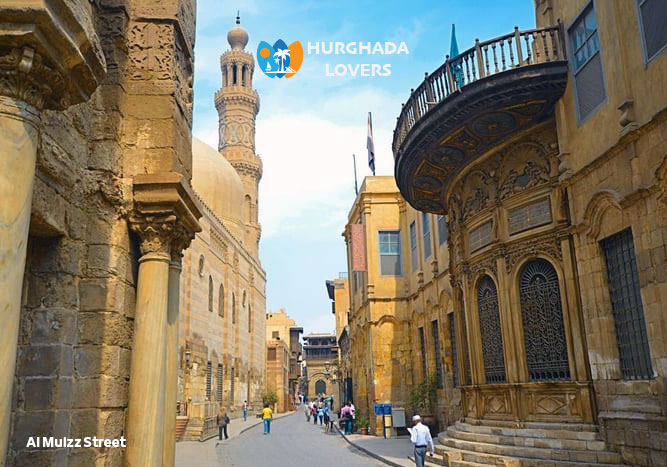Al Muizz Street in Cairo, Egypt | Facts Al Moez Ldin Allah Al Fatmi Street, History of The oldest historical streets Islamic Cairo, entrance ticket, opening times and more.
The Greatest Street Facts The oldest historical streets and the history of the Greater Cairo Kasbah The most important archaeological tourist attractions in Old Cairo, how much is the entrance ticket, opening times and more.
Al Moez Li Din Allah Al Fatimi Street, or as it is sometimes called the Greatest Street or another name, which is the Kasbah of Greater Cairo, is nothing but a street that represents the heart of the old city of Cairo, which had been developed before to serve as an open museum for both Islamic architecture and antiquities.
Hurghada lovers Offer Luxury Hurghada to Pyramids Tours | El Gouna to Pyramids Tours | Makadi bay to Pyramids Tours | Sahl Hasheesh to Pyramids Tours | Soma bay to Pyramids Tours .
Al Muizz Street
The history of the construction and establishment of this place
Al-Moez Street was established with the emergence of the city of Cairo, and that was during the era of the Fatimid state and their rule in Egypt, just as Al-Moez Street had arisen at that time. The layout of that city was penetrated by a main street that extended from the Bab Zuweila area in the south to the Bab Al-Futuh area in the north, i.e. parallel to the Gulf region.
It was called the Great Street at the beginning, but at a later stage it was called the Kasbah of Cairo, as it divided the city into two parts that are considered almost equal, and it was the political and spiritual center of the city.
However, with that major transformation that Cairo experienced at the beginning of the seventh century AH or the thirteenth century AD, and during the era of the Mamluk state, its name was changed to Al-Muizz Street.
The reason for being called by that name – Al Muizz Street
The street was called Al-Muizz Li-Din Allah, an ancient Fatimid street, in 1937, in honor of the founder of the city of Cairo. This name extends so far from Bab Al-Futuh to Bab Zuweila, including, of course, the streets of Bab Al-Futuh.
And also with her the Emir of the Army, and both of the coppersmiths, and between Kasserine, the Sagha area, the Ashrafieh area, and Al-Shawayen, both from Al-Akkadeen, and the Climate, and also the upholsterers, and finally Al-Sukaria in Bab Zuweila.
The current name also dates back to the era of the Fatimid ruler, Al-Mu’izz Lidin Allah, whose origin and history go back to the area of the island of Sicily.
While he was born inside the city of Mahdia, and that was in the year 319 AH, as the city of Cairo is attributed to him.
He had been pledged to take over the caliphate in the city of Morocco, and at that time he was the first Fatimid caliph to be able to enter Egypt, after its conquest occurred in the year 358 AH.
Archeology in that place
Of course, Al-Muizz Li-Din Allah Al-Fatimi Street, located in the downtown area of Cairo, is considered an Islamic antiquities museum, but it is open, and it summarizes the story of nearly 1040 years of history.
In that paragraph, he highlighted the most important of these important archaeological monuments:
1- Bab Al-Futuh area in 1087 AD
It is one of the gates of the walls in the city of Cairo, as it was established to control all the entrances to Cairo in the Fatimid era, and was established using towers of pharaonic stone.
2- Bab Zuweila in 1092 AD
It is also one of the gates in the walls of Cairo. It consisted of almost a very deep and huge building block, its height reached approximately 24 meters, higher than the original level of Al-Muizz Street.
3- Al-Hakim Mosque by Amr Allah 990-1013AD
The mosque was built during the reign of the Fatimid King, Al-Aziz Billah, and he was the one who started its construction in the year 379 AH / 989 AD, but unfortunately he had died before the completion of the construction, so his son al-Hakim completed its construction by the command of God in the knowledge of 403.
Therefore, after that it was attributed to him, and from that time it became known as the Al-Hakim Mosque, which is the second and most important mosque in Cairo in terms of breadth, and then after it is the archaeological mosque of Ibn Tulun.
4- Al-Aqmar Mosque, which was built in 1125 AD
It is considered the smallest mosque in Cairo, and it is also considered an original architectural masterpiece, as it is the only mosque that has so far been lower than the ground level.
It is also the first mosque that we found that its facade of the lock parallels the line of organization in the street, instead of being parallel to the courtyard, so that the dome takes its correct position.
What is the price of a ticket to visit Al Muizz Street for the Egyptians?
● Al-Moez Street visit ticket fees for adults: 10 Egyptian pounds
● As for the ticket fees for visiting Al-Moez Street for Egyptian students, it is: 5 Egyptian pounds
What is the price of a ticket to visit Al Muizz Street for foreigners?
● The fee for a visit ticket to Al-Moez Street is 100 Egyptian pounds
● In the event that the visitor is a foreign student, the entrance fee: 50 Egyptian pounds

